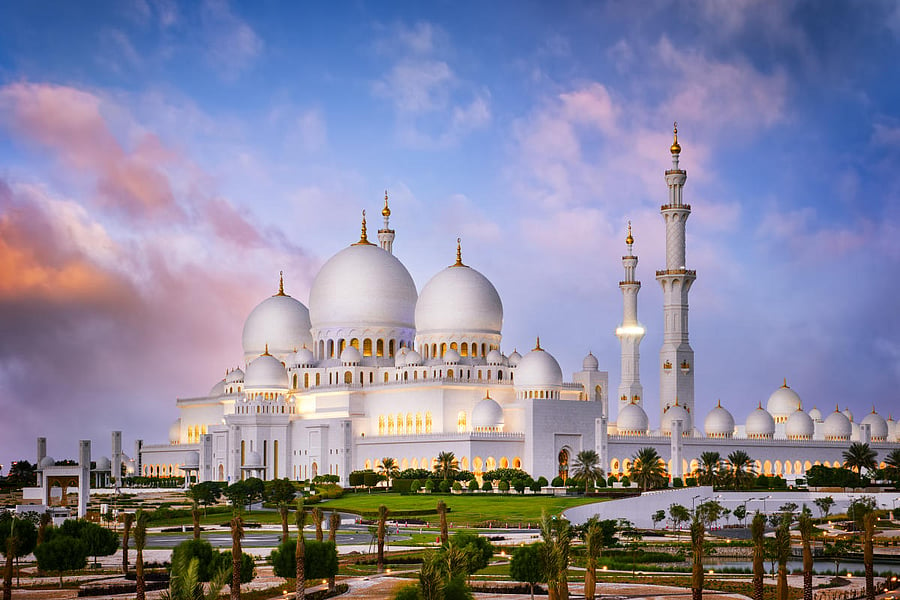
Mosques are not just places of worship. They come with their own stories, offering historic, cultural, and religious insight into the religion and community often with a side of impressive architecture. Though most of them may seem the same, with their domes and minarets and spacious prayer halls and courtyards, the newer structures also tend to reflect modern times, updated technology, and the host country’s culture.
What better time than to appreciate the beauty of these places of worship than the month of Ramadan? Here’s a glimpse of some architecturally stunning and unique mosques built in the last century:
Education City Mosque, Doha
The unconventionally built mosque was added to the Doha’s city skyline in 2015. It is part of the complex of Qatar Faculty of Islamic Studies and is an impressive example of contemporary religious architecture. The two minarets rise up to the sky, 90 metres up, in the direction of Mecca. The mosque rests on five large columns representing the five pillars of Islam. The exterior elevation features verses drawn from the Holy Quran and hundreds of small windows — the light that seeps through is bright and twinkling, representative of stars. Below are four streams of water, flowing from the surrounding gardens into the building; they represent wine, milk, honey and water. There are no columns inside, just a cavernous space with a high wall separating the main prayer hall from the female gallery room. Islamic calligraphy is the heart of the building, inscribed on every surface, from the ceramic tiles to the roof. The community mosque can hold 1,800 worshippers in its main prayer hall and 1,000 in its exterior courtyard.
Sheikh Zayed Mosque, Abu Dhabi
The design in the UAE’s largest mosque is said to be inspired by the Taj Mahal (the Mughal domes). The mosque sits at the top of the island, looking out onto the city. Its beauty lies in its opulence: gold-topped minarets, Italian marble courtyard capable of fitting 31,000 worshippers, embossed calligraphy on the inside of the 82 domes, a mother of pearl and white gold-studded minbar (pulpit) and columns emblazoned with semi-precious stones. The main prayer hall is home to a 12-tonne chandelier, designed to look like an upside-down palm tree and created with 24-carat gold, Swarovski crystal, and Italian Murano glass. Underneath is the largest hand-woven carpet in the world, sourced from Iran. The hall is surrounded by wide corridors, supported by columns designed to look like the date palm. By the side is Sheikh Zayed’s Tomb, in a private sanctuary; the late president passed away before the mosque opened in 2007. Only tour groups are allowed in the main hall. The mosque lights up at night, the colour chosen according to the position of the moon.
Malacca Straits Mosque, Malaysia
The ‘floating mosque’ is located on Pulau Melaka, a man-made reclaimed 40-hectare island off the city centre of Melaka. It overlooks the Strait of Melaka and is perched just above the water. At high tide, it gives the effect of floating on the waters. Its design combines Middle Eastern — the golden dome, and Malay craftsmanship — the corner turrets. The façade has stained glass and is decorated with Islamic motifs. A balcony or a walkway from the mosque leads out onto the water. The interiors, as compared to the outside, are simple — all white and spacious and lit up by natural light streaming in through the stained glass windows. Masjid Selat opened to the public in 2006. It is a place best viewed at sunset, and after.
Shah Faisal Mosque, Islamabad
Nestled at the foot of Margalla Hills, this mosque is one of Asia’s largest and the biggest in the country. Recognised as Pakistan’s national mosque, its architecture combines ultramodern and traditional, with geometric designs, sloping roofs and no domes. Designed by a Turkish architect (who won an international competition), its shape — eight-sided concrete shell with four gigantic slender and pointed minarets — is inspired by a Bedouin’s tent and the cubic Ka’ba in Mecca. The mosque was completed in 1986 and can hold 80,000 worshippers. Interiors are white marble decorated with mosaics, calligraphy and a Turkish-style chandelier. The mausoleum of the late President, Zia ul-Haq, is adjacent to the mosque. The mosque houses a library, lecture hall, museum and cafe.
Moscow Cathedral Mosque, Russia
First built in 1904, it was once the only mosque in the city. In 2011, reconstruction began on the remains of the old mosque. The new improved one opened in 2015. Cathedral Mosque has minarets similar in shape to Kazan Kremlin and Moscow Kremlin, to symbolise unity and friendship of the Russian and Tatar peoples. There’s a 46-metre-high golden dome, and pavilions covered with 12 kg of gold leaf. The design was chosen so that the mosque’s dome could blend in with a city skyline dominated by the golden domes of churches. The walls and ceilings have traditional Russian ornamental inscriptions, and calligraphic verses from the Quran, carved by Turkish craftsmen. There are handmade carpets and crystal chandeliers in the Byzantine-style building, which is accessible. As the biggest mosque in the country, it can accommodate about 10,000 people.
The Great Mosque of Algiers
Djamaa El Djazair sits on 400,000 sq m, overlooking the Bay of Algiers. It is the largest mosque in Africa, and the third biggest by area. It also has Africa’s tallest minaret at 870 metres, which will include observation decks and museums documenting different eras of Islam. The mosque is nearing completion and said to be opened by the end of the year. The complex includes a square praying hall and outside courtyard, together which can house up to 120,000 worshippers; an underground parking space, a Koranic school, a library, a restaurant, an amphitheater, and a research centre dedicated to the history of Algeria.